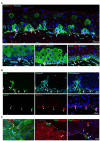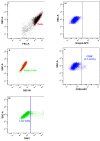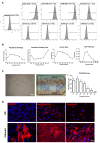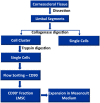Isolation and ex vivo Expansion of Limbal Mesenchymal Stromal Cells
- PMID: 35978577
- PMCID: PMC9350925
- DOI: 10.21769/BioProtoc.4471
Isolation and ex vivo Expansion of Limbal Mesenchymal Stromal Cells
Abstract
Limbal mesenchymal stromal cells (LMSC), a cellular component of the limbal stem cell niche, have the capability of determining the fate of limbal epithelial progenitor cells (LEPC), which are responsible for the homeostasis of corneal epithelium. However, the isolation of these LMSC has proven to be difficult due to the small fraction of LMSC in the total limbal population, and primary cultures are always hampered by contamination with other cell types. We recently published the efficient isolation and functional characterization of LMSC from the human corneal limbus using CD90 as a selective marker. We observed that flow sorting yielded a pure population of LMSC with superior self-renewal capacity and transdifferentiation potential, and supported the maintenance of the LEPC phenotype. Here, we describe an optimized protocol for the isolation of LMSC from cadaveric corneal limbal tissue by combined collagenase digestion and flow sorting with expansion of LMSC on plastic. Graphical abstract.
Keywords: Cornea; Expansion; Isolation; Limbal mesenchymal stromal cells; Limbal niche cells; Limbal stem cells.
Copyright © 2022 The Authors; exclusive licensee Bio-protocol LLC.
Conflict of interest statement
Competing interests The authors declare that they have no competing interests.
Figures







Similar articles
-
Efficient Isolation and Functional Characterization of Niche Cells from Human Corneal Limbus.Int J Mol Sci. 2022 Mar 2;23(5):2750. doi: 10.3390/ijms23052750. Int J Mol Sci. 2022. PMID: 35269891 Free PMC article.
-
P-Cadherin Is Expressed by Epithelial Progenitor Cells and Melanocytes in the Human Corneal Limbus.Cells. 2022 Jun 20;11(12):1975. doi: 10.3390/cells11121975. Cells. 2022. PMID: 35741104 Free PMC article.
-
Isolation and ex vivo Expansion of Human Limbal Epithelial Progenitor Cells.Bio Protoc. 2020 Sep 20;10(18):e3754. doi: 10.21769/BioProtoc.3754. eCollection 2020 Sep 20. Bio Protoc. 2020. PMID: 33659413 Free PMC article.
-
Characterization, isolation, expansion and clinical therapy of human corneal epithelial stem/progenitor cells.J Stem Cells. 2014;9(2):79-91. J Stem Cells. 2014. PMID: 25158157 Review.
-
Corneal epithelial stem cells at the limbus: looking at some old problems from a new angle.Exp Eye Res. 2004 Mar;78(3):433-46. doi: 10.1016/j.exer.2003.09.008. Exp Eye Res. 2004. PMID: 15106923 Review.
Cited by
-
Efficient Isolation and Expansion of Limbal Melanocytes for Tissue Engineering.Int J Mol Sci. 2023 Apr 25;24(9):7827. doi: 10.3390/ijms24097827. Int J Mol Sci. 2023. PMID: 37175529 Free PMC article.
References
-
- Al-Jaibaji O. , Swioklo S. and Connon C. J. ( 2019 . ). Mesenchymal stromal cells for ocular surface repair . Expert Opin Biol Ther 19 ( 7 ): 643 - 653 . - PubMed
-
- Chen S. Y. , Han B. , Zhu Y. T. , Mahabole M. , Huang J. , Beebe D. C. and Tseng S. C. ( 2015 . ). HC-HA/PTX3 Purified From Amniotic Membrane Promotes BMP Signaling in Limbal Niche Cells to Maintain Quiescence of Limbal Epithelial Progenitor/Stem Cells . Stem Cells 33 ( 11 ): 3341 - 3355 . - PubMed
LinkOut - more resources
Full Text Sources

